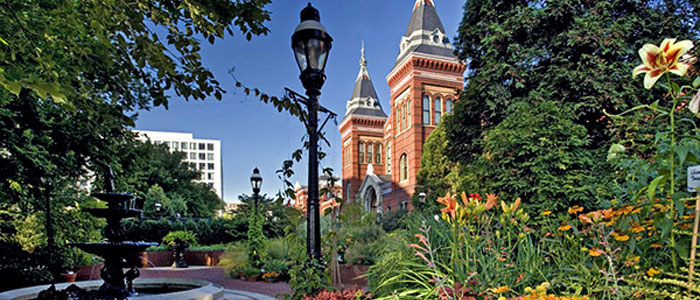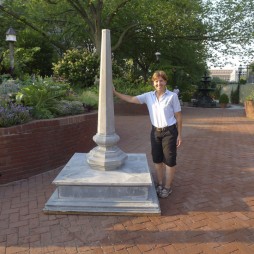Down to Earth
The Mary Livingston Ripley Garden is an oasis of tranquility between the Hirshhorn Museum and the Arts and Industries Building. Horticulturist Janet Draper of Smithsonian Gardens is responsible for the day-to-day maintenance and nurturing of this garden, which is beloved by so many staff and visitors.
Thanks to Janet’s resourcefulness, the garden has a new addition. “For the past year I have been mesmerized with the entire process of the restoration of the Arts and Industries Building. I had been watching the various pieces of ornamentation coming down off the rooftop and was totally astounded by not only the size, but the beautiful details and complexity of some of the pieces,” she says.
Janet realized that all the roof ornamentation was made of galvanized sheet metal and wondered if it would all be going back up after restoration. If not, perhaps she could have a fragment for the Ripley Garden—very neatly tying her red brick garden in with the red brick Arts and Industries Building. The piece would also give her a way to weave the story of the building’s restoration into her popular garden tours.
Over the years, Janet has become acquainted with the construction crew at A&I. Thinking that it never hurts to ask, she asked Construction Manager Pat Ponton, if any architectural fragments might be available for her garden. When Pat told her that he could give her a 1970s replica of one of the original finials, she knew exactly where it would go.
“For a long time I had been thinking that the Ripley Garden needed something special to replace the birdhouses that I have had for many years at the northern entry of the garden,” Janet says. “The birdhouses have been great—the public loved them and those ‘in the know’ appreciated the nod to Secretary S. Dillon Ripley (he was an ornithologist). But they had become a bit worn and needed to be replaced,” she continues. So, on the first day of summer, with the able assistance of Sammy, the tower crane operator, and a couple of guys from the wonderful Grunley construction team, the piece of ‘architectural salvage’ found a new home a little closer to the ground. I am very thankful to the crew working on the Arts and Industries who have been so kind to me and careful with the garden.”
Next time you walk in the Ripley Garden, take a look at this piece of history—a subtle nod to the Arts and Industries Building in the northeast corner.
Posted: 4 September 2012
- Categories:





